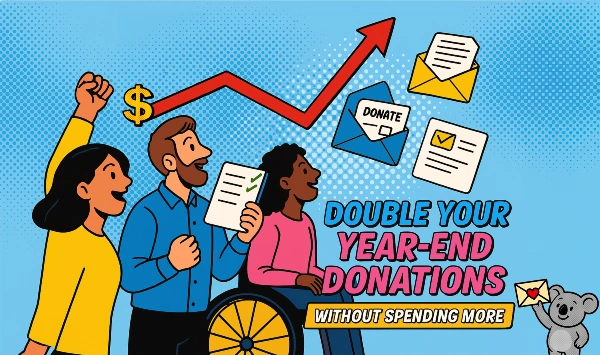There’s a chance budget cuts are coming for your organization. The COVID-19 crisis is hitting a lot of organizations hard, mainly for these three reasons:
- Cancelled fundraising events.
- Lost revenue from cancelled activities that bring in critical revenue.
- Non-existent fundraising.
That last one is self-inflicted. Those who have been raising funds over the last few weeks and months have been doing exceedingly well. But that’s no comfort for those who have chosen to go silent on their donors. Lost revenue is lost revenue, no matter what the cause.
A recent Charity Navigator survey about the financial impact of the COVID-19 crisis on nonprofit organizations found that 83% of respondents reported they are suffering financially.
And that means budget cuts. A lot of them.
Not all cuts are equal. Some are deeply destructive and can lead to years of financial hardship, or even bankruptcy.
But some may not be so bad. Knowing the difference could mean the difference between survival and a healthy recovery as the crisis eases.
The budget cut to fight
Don’t cut new donor acquisition. This will be a tough battle, but you should fight it like a rabid weasel.
I’m pretty sure the knife-wielders have their eyes on your donor-acquisition program. They imagine it’s a big, juicy, painless cut. Most likely, acquisition is a net cost to your organization. That means every dollar cut from acquisition improves your bottom line while the pressure is on.
But here’s the problem: Cutting donor acquisition doesn’t inflict much immediate pain, but it’s going to hurt in the future. It’s going to hurt a lot, and not just people’s feelings. Abandoning acquisition can create catastrophic and lasting financial impacts in the form of depressed fundraising for years to come.
The hard-to-see truth is that donors grow more valuable to the organization every year they’re with you. Their responsiveness, retention, even their likelihood of upgrading their giving amounts — they all increase every year they are with you. Here’s how it plays out:
- At the point of acquisition, you’re losing money. Almost everyone does. (Though it’s worth noting that right now, at the height of the crisis, many are bringing in new donors at a profit! But that’s not normal.)
- If your program is healthy and consistent, you’ll start to break even on that initial investment in 12 to 18 months (give or take a few!)
- After another year, you’re earning a 2-to-1 return from those donors who are still with you.
- In the third year, your return rises to around 3-to-1. Starting to look good.
- The real payoff comes in the fourth and following years, when those established donors are returning $10 (or more) for every dollar you spend.
- More important are those who upgrade to higher levels: Those who become major donors, bequest donors, or monthly donors. If you don’t get any new donors, you don’t have a source for those super-important donors.
- Those cuts to donor acquisition leave a black hole in the middle of your donor base — a vacuum where there should have been responsive, committed donors.
Every fundraising campaign you launch for years to come will do worse than it should, because you’re missing those donors who didn’t join you because you cut fundraising. It’s not just fewer bodies. It’s fewer committed supporters. And that empty donor class continues to echo through your fundraising. The pain tends to peak three to four years after the cuts, but it will be meaningful and measurable for seven to 10 years.
Do your budget-cutters know this? Would they still make the “easy” cuts to donor acquisition if they did? They might think that cutting acquisition is no worse than getting a bad haircut. But it’s actually more like amputating your legs.
The budget cut you can make
You might do better in the critical battle to protect donor acquisition if you’re willing to give the knife guys something they can slash without a fight. After all, there’s a big hole in your budget that you have to deal with!
This is going to make me spectacularly unpopular in some quarters, but I’m putting the whole class of branding and awareness activities in the go-ahead-and-cut category. That’s because there’s no direct, measurable connection between those expenses and any meaningful impact on your bottom line. Cutting these activities doesn’t hurt in the short term — or in the long term.
Spending on advertising is an act of faith. Faith can be a beautiful thing, but it’s not the best basis for business decisions. In hard times, you’ve got to put your dollars into measurable activities, like direct response fundraising.
Some brand advocates will tell you their work is measurable. They’ll cite metrics like “unaided recall” — meaning that when surveyed, more people mention your organization’s name than did before — or “aided recall,” where people claim to have heard your name when they hear it.
Pardon me, but do you mind if I roll my eyes? Measuring “recall” and things like it is almost completely bogus.
It’s possibly true (though it can’t be proven) that someone who’s heard of you is more likely to donate than someone who hasn’t heard of you. But that’s not a fact you can take to the bank. For one thing, it doesn’t cost anyone a cent to tell you they’ve heard of you — it’s just a thought, an idea. For another thing, as all direct marketers know, the divide between what people say and what they actually do is wide. Since we’re talking budgets here, stuff you can take to the bank is pretty much the whole thing.
Think of it this way: Would you rather move 100 people 10% of the way toward giving or move 10 people 100% of the way toward giving?
In the first scenario — which is a branding or awareness campaign — your revenue is zero, no matter how much you spent. In the second scenario — a classic direct-response fundraising campaign — you end up with revenue. The only question is whether it came at an acceptable cost.
In flush, easy, noncutting times, you might be able to spend money on speculative ventures like branding and awareness and be okay with the non-measurable benefits that could come as a result.
But not when the budget cutters are active. So hand branding activities over to the knifers. It’s how you might survive beyond the next year or two.
Looking for help with the hard decisions you face in the coming months? Get one of our expert Fundraisingologists at your side through Moceanic’s Coaching+. We’ll work with you and your leaders to make the right moves that will build a solid future! Check it out here.
Related Posts:









